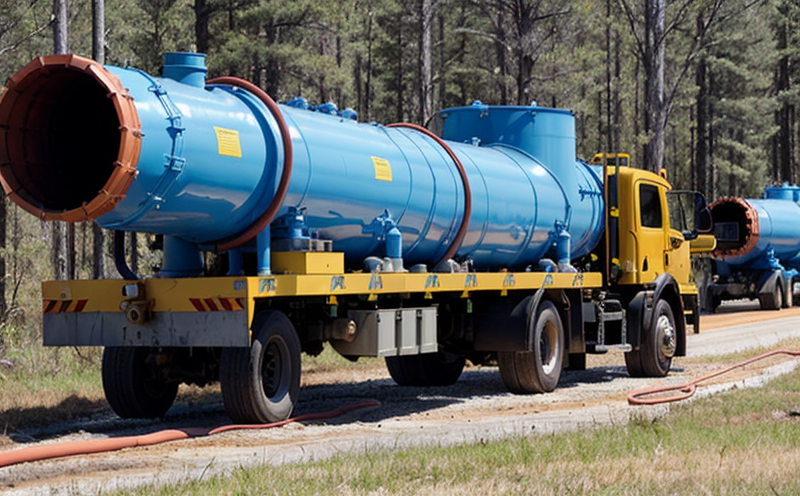ASTM G123 Stress Corrosion Cracking Testing of Pipeline Materials
The ASTM G123 stress corrosion cracking (SCC) test is a critical method used to evaluate the susceptibility of pipeline materials to SCC. This form of testing plays an essential role in ensuring the integrity and safety of natural gas distribution pipelines, which are under significant operational pressures.
Stress corrosion cracking can occur when metal alloys undergo simultaneous exposure to specific environmental conditions (such as chloride environments) and tensile stresses. The resulting cracks can compromise the structural integrity of a pipeline, leading to catastrophic failures with severe consequences for public safety and infrastructure. Therefore, ASTM G123 testing is mandatory in the natural gas distribution sector to prevent such failures.
The test involves subjecting specially prepared specimens to a chloride-containing environment under tensile stress. The specimen’s resistance to crack propagation is then evaluated after exposure. This process simulates real-world conditions that may lead to SCC, thereby identifying materials with inherent susceptibility or those that have been inadequately protected against corrosion.
The ASTM G123 test is widely recognized and used in the industry for its accuracy and reliability. It helps manufacturers ensure the quality of their products by validating their material selection processes. Additionally, it assists operators to make informed decisions regarding pipeline maintenance schedules and repair strategies.
In summary, ASTM G123 testing ensures that natural gas distribution pipelines are constructed from materials capable of withstanding environmental challenges without compromising safety or performance. This test is a cornerstone for maintaining the reliability and longevity of these crucial infrastructure components.
- Environmental Impact: By identifying susceptible materials early in the manufacturing process, ASTM G123 testing helps prevent pipeline failures that could lead to harmful releases of natural gas into the environment.
- Safety Enhancement: Ensuring pipelines are made from corrosion-resistant materials reduces the risk of explosions and leaks, thus protecting both personnel and public safety.
- Economic Benefits: Early detection of SCC-prone materials saves costs associated with potential pipeline failures. It also helps in optimizing maintenance schedules by targeting areas prone to cracking.
The ASTM G123 test is a vital component in the continuous improvement and reliability of natural gas distribution pipelines. Its significance cannot be overstated, as it ensures that critical infrastructure operates safely and effectively under challenging conditions.
Why Choose This Test
Selecting ASTM G123 stress corrosion cracking testing for pipeline materials offers several advantages over other forms of material evaluation:
- Industry Standard: ASTM G123 is widely recognized and used globally, ensuring compatibility with international standards and best practices.
- Comprehensive Evaluation: The test provides a comprehensive assessment of pipeline materials' susceptibility to SCC under specific environmental conditions.
- Predictive Capability: By identifying potential issues early, the ASTM G123 test helps predict material performance in real-world scenarios, thereby reducing the risk of failures.
- Rigorous Protocol: The standardized protocol ensures consistent and reliable results across different laboratories and testing facilities.
- Regulatory Compliance: Adhering to ASTM G123 standards is essential for compliance with regulatory requirements, ensuring that materials meet stringent quality control criteria.
The test's rigorous nature and industry-wide acceptance make it a trusted choice for quality managers, compliance officers, R&D engineers, and procurement professionals. By choosing ASTM G123 testing, these stakeholders ensure that they are working with materials that have been rigorously evaluated and certified as safe for use in natural gas distribution pipelines.
Customer Impact and Satisfaction
The implementation of ASTM G123 stress corrosion cracking testing has a significant positive impact on customers by ensuring the safety, reliability, and longevity of natural gas distribution pipelines. This, in turn, enhances customer satisfaction and trust in the services provided:
- Enhanced Safety: By preventing potential failures caused by SCC, the test ensures that pipelines operate safely, minimizing risks to both personnel and public.
- Improved Quality Assurance: The standardized testing process provides consistent and reliable results, ensuring high-quality pipeline materials are used in construction and maintenance projects.
- Cost Efficiency: Early detection of SCC-prone materials helps avoid costly repairs and replacements later on. This leads to more efficient use of resources and budget optimization for customers.
- Regulatory Compliance: Meeting ASTM G123 standards ensures that customers are compliant with relevant regulations, avoiding potential legal issues and penalties.
Customer satisfaction is directly linked to the reliability and safety of natural gas distribution pipelines. By choosing ASTM G123 stress corrosion cracking testing, customers can rest assured that their infrastructure meets the highest quality and safety standards.
Environmental and Sustainability Contributions
- Reduction in Emissions: Ensuring pipeline integrity through ASTM G123 testing reduces the risk of gas leaks, which can lead to greenhouse gas emissions. This contributes positively to environmental sustainability.
- Economic Efficiency: By identifying and addressing potential issues early, the test helps prevent costly repairs and replacements, leading to more efficient use of resources and economic sustainability.
- Social Responsibility: Ensuring safe and reliable pipelines through ASTM G123 testing aligns with social responsibility goals by protecting communities from potential hazards.
The ASTM G123 stress corrosion cracking test plays a crucial role in promoting environmental and sustainability practices within the natural gas distribution sector. It helps to minimize operational risks, reduce waste, and enhance overall efficiency, contributing to a more sustainable future.





